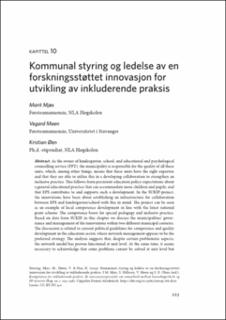| dc.contributor.author | Mjøs, Marit | |
| dc.contributor.author | Moen, Vegard | |
| dc.contributor.author | Øen, Kristian | |
| dc.date.accessioned | 2023-10-11T09:57:29Z | |
| dc.date.available | 2023-10-11T09:57:29Z | |
| dc.date.created | 2023-03-27T15:56:09Z | |
| dc.date.issued | 2023 | |
| dc.identifier.citation | Mjøs, M., Moen, V. & Øen, K. (2023). Kommunal styring og ledelse av en forskningsstøttet innovasjon for utvikling av inkluderende praksis. I M. Mjøs, S. Hillesøy, V. Moen og S. E. Ohna (red.), Kompetanse for inkluderende praksis. Et innovasjonsprosjekt om samarbeid mellom barnehage/skole og PP-tjeneste (Kap. 10, s. 223–246). Cappelen Damm Akademisk. | en_US |
| dc.identifier.isbn | 978-82-02-79483-5 | |
| dc.identifier.uri | https://hdl.handle.net/11250/3095753 | |
| dc.description.abstract | As the owner of kindergarten, school, and educational and psychological counselling service (PPT), the municipality is responsible for the quality of all these units, which, among other things, means that these units have the right expertise and that they are able to utilize this in a developing collaboration to strengthen an inclusive practice. This follows from persistent education policy expectations about a general educational practice that can accommodate more children and pupils, and that EPS contributes to and supports such a development. In the SUKIP-project, the innovations have been about establishing an infrastructure for collaboration between EPS and kindergarten/school with this in mind. The project can be seen as an example of local competence development in line with the latest national grant scheme: The competence boost for special pedagogy and inclusive practice. Based on data from SUKIP, in this chapter we discuss the municipalities’ gover nance and management of the innovations within two different municipal contexts. The discussion is related to current political guidelines for competence and quality development in the education sector, where network management appears to be the preferred strategy. The analysis suggests that, despite certain problematic aspects, the network model has proven functional at unit level. At the same time, it seems necessary to acknowledge that some problems cannot be solved at unit level but must be addressed to the municipal level. Finding answers to such problems may require basic organizational development with learning loops both vertically and horizontally in the municipality. | en_US |
| dc.language.iso | nob | en_US |
| dc.publisher | Cappelen Damm Akademisk | en_US |
| dc.relation.ispartof | Kompetanse for inkluderende praksis : Et innovasjonsprosjekt om samarbeid mellom barnehage/skole og PP-tjenesten | |
| dc.rights | Navngivelse-Ikkekommersiell 4.0 Internasjonal | * |
| dc.rights.uri | http://creativecommons.org/licenses/by-nc/4.0/deed.no | * |
| dc.subject | SUKIP | en_US |
| dc.subject | nettverksledelse | en_US |
| dc.title | Kommunal styring og ledelse av en forskningsstøttet innovasjon for utvikling av inkluderende praksis | en_US |
| dc.type | Chapter | en_US |
| dc.description.version | publishedVersion | en_US |
| dc.subject.nsi | VDP::Samfunnsvitenskap: 200::Pedagogiske fag: 280 | en_US |
| dc.source.pagenumber | 223-246 | en_US |
| dc.identifier.doi | 10.23865/noasp.186.ch10 | |
| dc.identifier.cristin | 2137319 | |
| dc.relation.project | Norges forskningsråd: 296636 | en_US |
| cristin.ispublished | true | |
| cristin.fulltext | original | |
| cristin.qualitycode | 1 | |

